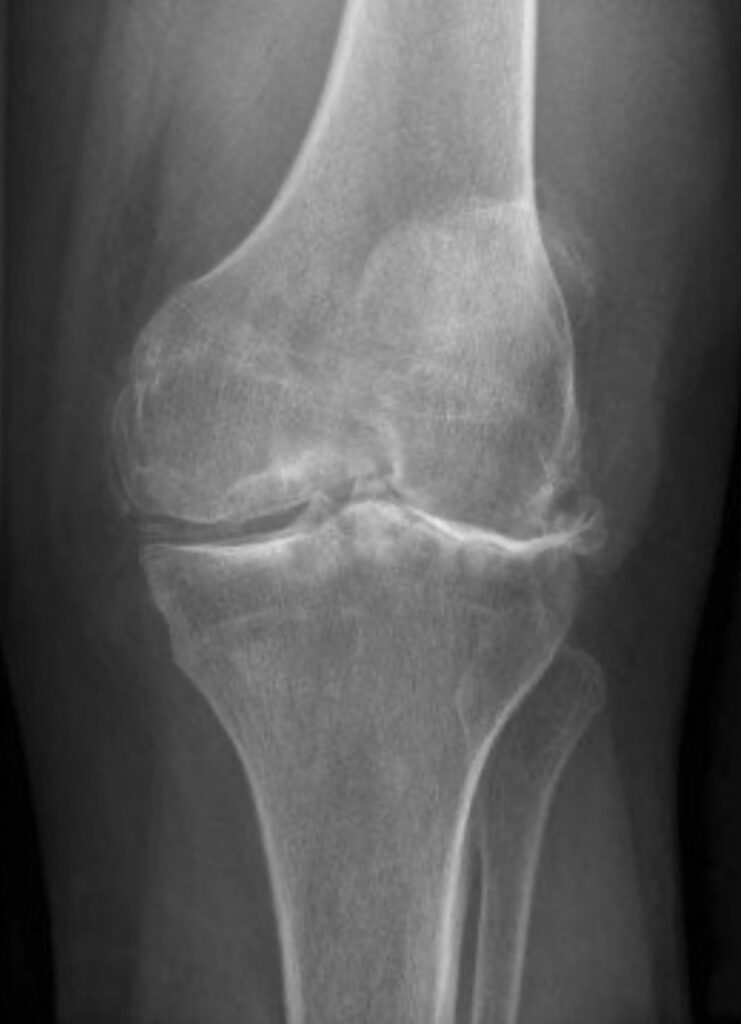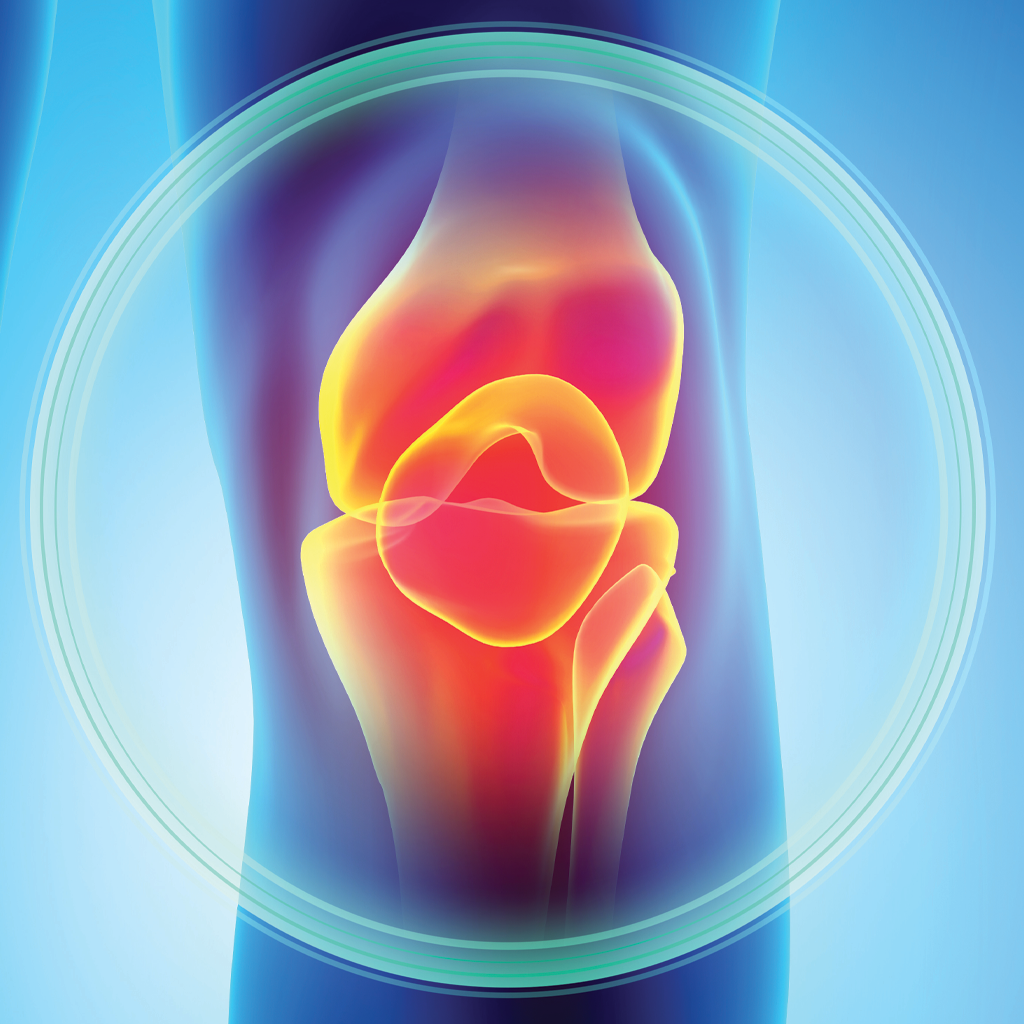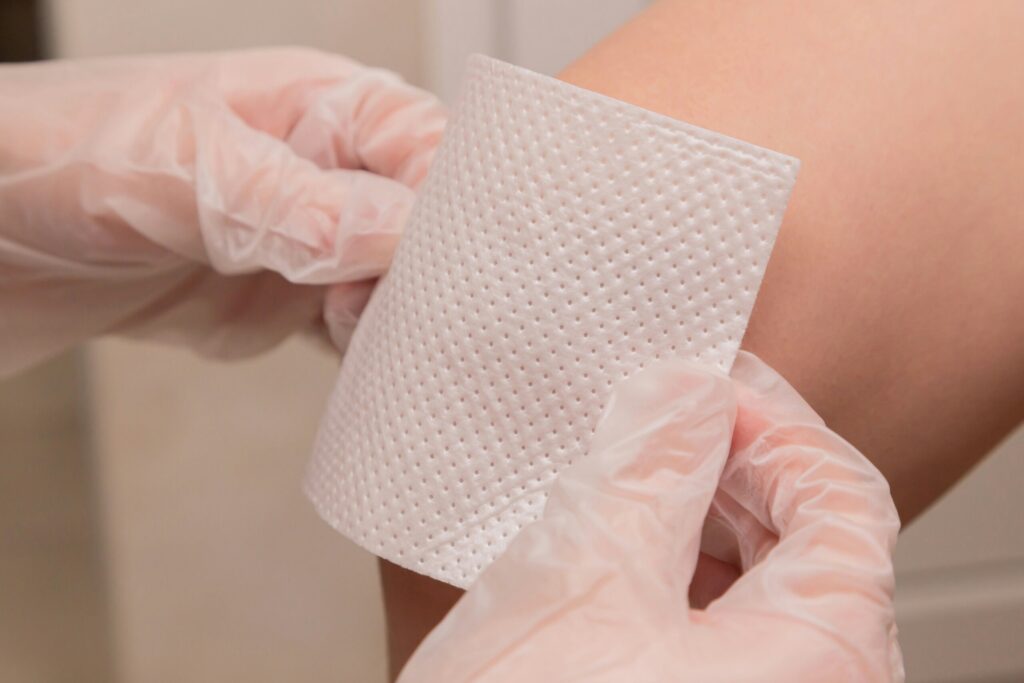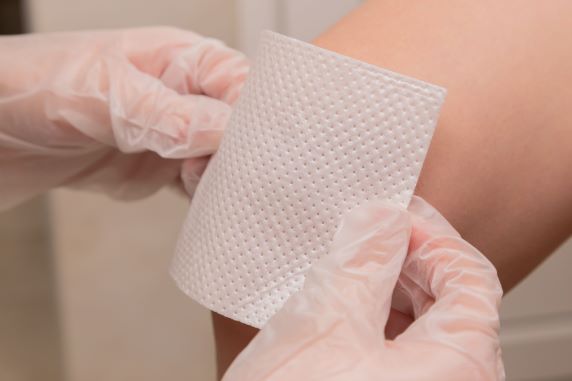If you are living with knee osteoarthritis, it’s important to understand that this disease is progressive. And, as the disease advances, symptoms will worsen and mobility in your joints may be compromised. But what are the stages of knee osteoarthritis? And how can you find relief from painful symptoms? Here’s what you need to know!

What is Knee Osteoarthritis?
Knee osteoarthritis is a disease that can affect your joint function and mobility. As we mentioned above, the disease is progressive and has no cure. However, there are stages of disease. And if you intervene before mobility is compromised, you may be able to stay active and delay or prevent further progression.
Stage 0: A Healthy Knee
If you show no symptoms of knee osteoarthritis, and there is no evidence of joint damage, your disease is classified as Stage 0. At this point, no treatment or intervention is recommended.
Minor Knee Osteoarthritis Pain: Stage 1
At this stage, your knee joints may show minor signs of wear and tear. You may also have slight growths of bone spurs on your joints, but you’re unlikely to experience pain. Still, if you have risk factors for arthritis, engaging in exercises for knee health could help prevent progression into stage two.
Stage 2
Here, we will notice more signs of bone spur growth when we x-ray your knee joints. Typically, the spaces between your joints will still appear normal, however, patients with stage 2 knee osteoarthritis are likely to experience symptoms such as joint pain and stiffness, especially after exercising, sitting for extended periods, or when you first wake up in the morning. Stage 2 patients may also start to experience cartilage break down. For some patients, progression and pain may be managed with lifestyle measures, including wearing braces or supports and focusing on strength training and exercise. However, some people will need additional interventions to find relief.
Moderate Knee Osteoarthritis: Stage 3
At this point, we will detect obvious cartilage erosion between your bones; the gap between bones will also have narrowed. At this point, inflammation in your joints will leave you experiencing frequent pain and stiffness. You may also notice that your knee makes a popping noise when you walk. Some stage 3 patients can manage their pain with medications. But, again, additional interventions may be necessary.
Stage 4
This is a severe stage of knee osteoarthritis—at this point of disease progression, your joint will be stiff because the cartilage has worn down significantly, leaving very little space between bones. Your synovial fluid that lines your knee joint will also decrease, so that you experience pain and friction when you try to move your joint. At stage 4, doing something as simple as trying to walk down the stairs could cause excruciating pain. As such, patients who reach this stage of disease progression are often forced to seek surgical treatments in order to relieve their discomfort. However, if you choose to seek help for knee osteoarthritis when you are still in stage two or three, the experts at the Texas Knee Institute can help relieve your pain with a non-surgical medical procedure.
Genicular Artery Embolization for Stage 2 and 3 Knee Osteoarthritis Relief
Genicular artery embolization (GAE) is a non-surgical procedure that can slow knee osteoarthritis progression. Recommended for stage 2 and 3 osteoarthritis patients who have not found relief from other, non-surgical interventions, it diminishes blood flow to the lining of your knee, reducing pain, inflammation and other symptoms. After undergoing GAE, you should be able to walk within two to three hours. Most patients will return to normal activities the day after the procedure, with symptom reduction becoming apparent within weeks of the procedure.
Ready to find relief for your arthritis symptoms, without the need for surgery? We’re here to help. Click here to request an appointment Click here to request an appointment Click here to request an appointment at the Texas Knee Institute.
Walking backward is a hot new fitness trend. Experts say that it helps reduce your risk for running injuries while mixing up your training routine. But can it help prevent or relieve the knee pain of osteoarthritis? here's what you need to know!

Walking Backward and Osteoarthritis Pain
When you're living with osteoarthritis knee pain, you may experience symptoms such pain, stiffness, swelling and limits on your range of motion. Now, many people will seek a medical procedure to relieve the discomfort of these symptoms. And, certainly, an intervention like Genicular Artery Embolization can relieve arthritis pain without the need for invasive knee replacement.
However, for those who are looking to manage their condition with lifestyle measures, walking backward may offer some important benefits, according to the experts. Why is that the case? When you walk backward, you use different muscles than when you propel yourself forward. Immediately, that can relieve some of the pressure on your sore, swollen joints.
Moreover, when you walk backward, you give more engagement to the quad muscles. This can stretch out the knee muscles, once again alleviating pain and also improving mobility. Finally, backward walking involves more thinking than moving forward, and this can help with balance and brain engagement as you age. Of course, this form of exercise can also come with a higher risk of tripping and falling. So you should practice the movement indoors, at a slow pace, and supervised by a friend or loved one to reduce your hazard risk.
When Walking Backward Doesn't Provide Enough Relief
If you're suffering from mild to moderate knee arthritis, lifestyle measures may provide sufficient pain relief. But if your condition is more severe, and you want relief without surgery, we encourage you to explore genicular artery embolization in Texas. Click here to request an appointmentClick here to request an appointmentClick here to request an appointment!
What's the best way to treat arthritis in knee? While there are many ways to relieve knee pain due to arthritis, one option is emerging as optimal because it is a lasting, non-surgical treatment for osteoarthritis of the knee. Called genicular artery embolization, or GAE, it's a minimally invasive procedure that reduces arthritis-related knee pain by reducing blood flow to the inflamed lining of the knee. But how does it work, who's a candidate, and why is it a great alternative to knee surgery? Here's what you need to know!

Best Way to Treat Arthritis in Knee: What are the Options?
Remember, knee osteoarthritis is a progressive, degenerative condition. As such, you need to seek some kind of treatment, or you'll experience disease progression and worsening Knee Osteoarthritis symptoms. Now, some patients can treat arthritis in the knee simply by maintaining an optimal weight, engaging in regular exercise and following a heart-healthy diet. However, many patients will still experience pain, stiffness and other disruptive symptoms unless they seek medical intervention.
Until recently, the main treatment option involved surgical knee replacement. But many people want knee pain relief without surgery, while others can not tolerate surgical interventions. In the past, that meant they were forced to suffer from arthritis pain without relief. Today, though, they can choose to undergo GAE, an alternative knee replacement that is the best way to treat arthritis in the knee without surgery.
What is GAE?
GAE is a surgical alternative for relieving symptomatic osteoarthritis of the knee. During this GAE procedure, our interventional radiologists insert a small catheter into your femoral artery, usually via a small puncture made in the area of your groin. We'll then guide the catheter to your genicular arteries, assisted by advanced X-ray imaging. Once the catheter reaches its target, we'll deposit tiny coils into the arteries, thereby decreasing and reducing osteoarthritis knee pain and inflammation.
Now, not everyone is a candidate for genicular artery embolization. But many have found that this is the best way to treat arthritis in knee without surgery. Ready to see if this is your best pathway to relief? Click here to request an appointmentClick here to request an appointmentClick here to request an appointment!
As one of the hottest sports among older adults, many athletes are finding it harder to get into matches because of pickleball knee pain. Now, this game is supposed to be gentler on your joints than sports like tennis or running. But if you have osteoarthritis in your knees, staying active on the court can be a real challenge. And that's where GAE, or genicular artery embolization, can help!

What Causes Pickleball Knee Pain?
According to Paddletek, there are 36.5 million pickleball players in the US. And, of those players, more than 50% are over the age of 55, while more than 30% are 65 and older. Now, staying active at that age can certainly increase your risk for certain knee injuries, including muscle and ligament strains. (Your risk will increase dramatically if you already have limited mobility in your joints.)
Stretching before and after a game; wearing supportive foot gear; and listening to your body can help avoid sport-related injury. But if your pickleball knee pain is due to osteoarthritis, you may find relief from a different source: the GAE alternative knee replacement procedure.
That was true for 80-year-old Patrick Shruben, who recently discussed his 2021 GAE knee procedure with UCLA Health. The avid athlete wanted relief from pickleball knee pain, but “did not want to sit in pain for months after surgery.” So, after some research, he underwent GAE, and says, "My treatment was pretty amazing. I walked without knee pain the next day.”
Even better? For those wondering about the efficacy of GAE relief, Shruben is still going strong, two years after his procedure. Today, he says, “Here I am at 80, and I’m doing things my own children can’t do.”
GAE Knee Procedure at the Texas Knee Institute
Ready to put pickleball knee pain in your rearview mirror? Want to relieve osteoarthritis knee pain without surgery? Click here to request an appointmentClick here to request an appointmentClick here to request an appointment. When you come into the office, we'll review your candidacy for GAE and make personalized treatment recommendations.
If you want relief from the chronic pain and swelling of osteoarthritis without surgery, you may be seeking an alternative knee replacement. After all, some people aren't good candidates for surgery. And others may prefer to delay a knee replacement, since artificial knees are unlikely to last longer than 20 years.
Now, it's important to remember that arthritis can't be cured. But you can relieve pain and swelling, and preserve your mobility, often without surgery. Here's what you need to know.

Home Remedies for Arthritis Knee Pain
Certain lifestyle measures can help relieve knee pain due to osteoarthritis as an alternative knee replacement. First, consider losing weight, as this will relieve some of the stress and pressure on your knee joints. This can also help delay the destruction of cartilage in your knee.
Engaging in low impact exercise, such as swimming or walking on a treadmill, can help you maintain mobility and limit stiffness. And, for many people, over-the-counter medications, including NSAIDs (nonsteroidal, anti-inflammatories) can help manage pain and inflammation, as long as your doctor clears you to use this category of medication.
Alternative Knee Replacement Treatments
Several medical interventions can temporarily relieve osteoarthritis knee pain while still allowing you to avoid surgery. Some patients will benefit from shots of cortisone or hyaluronic acid, because they can relieve inflammation and improve joint lubrication. The effects of these injections typically last a few months.
However for relief that lasts a year or more, patients may prefer to schedule genicular artery embolization, or GAE, an alternative knee replacement that relieves osteoarthritis related knee pain by reducing blood flow to the knee joint. This relieves pain and inflammation, and can even slow disease progression, helping you avoid or delay knee replacement surgery.
Ready to see if GAE is the right option to relieve your knee pain? If you have moderate to severe osteoarthritis knee pain, are between the ages of 40 and 80, and haven't found relief from conservative arthritis treatments, you may be a GAE candidate. Click here to request an appointmentClick here to request an appointmentClick here to request an appointment with the Texas Knee Institute, so we can discuss your options!
Our specialists at the Texas Knee Institue relieve the pain of knee osteoarthritis by performing genicular artery embolization (GAE). This is a minimally invasive procedure that reduces pain while improving mobility; it works by blocking blood flow to your knee's synovial lining in order to target inflammation. Now, this treatment has been helpful to patients with moderate to severe arthritis pain who can't or don't want to undergo knee replacement surgery. But they do want to know about the genicular artery embolization recovery period. And here are all the important details.

Genicular Artery Embolization Recovery Immediately after the Procedure
A typical GAE procedure lasts between 1 and 2 hours. Aferward, we'll keep you under brief observation, and you should be able to walk--and go home--on that same day.
The next day, you'll be allowed to resume light activities. Within three days of the procedure, you can resume full activity levels, avoiding long stair climbs or heavy lifting. By two weeks post-procedure, the recovery should be complete and you can enjoy the full benefits of the GAE procedure.
How Long Does it Take to Recover From GAE?
Following GAE, you should only notice mild side effects, such as light bruising or minor skin changes. Within two weeks, your recovery should be complete. At that point, you'll notice:
- Less swelling and knee pain
- Reduced stiffness
- Improvements in functionality and mobility
Clearly, following genicular artery embolization recovery, patients experience noticeable osteoarthritis knee pain relief, with results lasting for up to a full year. We therefore recommend this treatment for patients suffering from moderate to severe arthritis pain, who can't or prefer not to undergo a complete knee replacement surgery. Ready to see if GAE is your pathway to arthritis relief? Click here to request an appointmentClick here to request an appointmentClick here to request an appointment with our knee specialists in Texas!
If you have developed arthritis in the knee, you may be seeking treatment for arthritis knee pain. But what is arthritis, why does it cause pain and what are your treatment options? Keep reading to find out.

What is arthritis of the knee?
Arthritis is a term that describes swelling and tenderness in one or more of your joints. If you have arthritis of the knee, joints in one or both knees may be affected, leading to additional symptoms such as pain and stiffness. Osteoarthritis is the most common form of the disease to impact your knee joints. And, while the disease is progressive and has no cure, there are treatments available to help relieve your pain.
Treatment for Arthritis Knee Pain
When you have arthritis in one or both knees, it’s important to seek early intervention. With prompt treatment, you can maintain mobility, manage pain and delay or prevent disease progression.
For some people, pain can be relieved with heating pads and over-the-counter non-steroidal anti-inflammatories. Physical therapy and regular exercise can help preserve your mobility. But, when those treatments fail to fully offer relief, and you aren’t ready for surgery, aren’t a surgical candidate, or simply wish to delay this invasive treatment option, it’s time to explore genicular artery embolization (GAE), an alternative to surgical treatment for arthritis knee pain.
What is GAE?
GAE is a non-surgical procedure that slows osteoarthritis progression in your knee. Because it is minimally invasive, and lasts just about two hours, this treatment won’t require hospitalization or general anesthesia.
During the procedure, we’ll administer an anesthetic through a small puncture in your groin. Then, we’ll use that access point to insert a thin catheter into your femoral artery, guiding it to your knee’s genicular artery with the help of X-ray imaging.
Once the genicular arteries are in sight, we release small embolic materials into your vessels, limiting blood flow to the lining of your knee and reducing pain, inflammation and other symptoms of knee arthritis. Finally, we extract your catheter, cover your puncture site with a sanitized bandage, and send you home a few hours later, when you’re able to walk. The day after choosing this treatment for arthritis knee pain, you’ll be able to resume your normal activities. And, within weeks, you should experience noticeable arthritis symptom relief.
Choosing GAE for Treatment of Arthritis Knee Pain in Texas
Ready to see if you’re a candidate for GAE in Houston or Dallas? This may be your ideal treatment if you
- Have a formal knee osteoarthritis diagnosis
- Are living with moderate to severe knee pain and stiffness
- Haven’t found relief through medications or conservative treatment options
- Are between the ages of 40 and 80, in generally good health
Do you meet these criteria and are ready to find your pathway to relief? Click here to request an appointmentClick here to request an appointmentClick here to request an appointment with our experts at the Texas Knee Institute.
If you’re considering an alternative knee replacement, you may worry about genicular artery embolization side effects. But what is this procedure, how does it relieve arthritis-related knee pain and what, if any, side effects should you expect? Keep reading to find out.

What is Genicular Artery Embolization (GAE)?
GAE is a minimally invasive treatment option for people living with osteoarthritis (OA) of the knee. At the Texas Knee Institute, our interventional radiologists perform this outpatient procedure with local anesthesia, allowing you to remain awake and pain-free, while avoiding an overnight hospital stay!
Once the anesthetic takes effect, our specialists insert a catheter through a small opening in the leg, guiding it to the blood vessels supplying your knee joint. Once x-ray imaging confirms the catheter is in the proper place, we inject tiny body-safe beads into your knee lining (synovium.) Afterward, the reduced blood flow to the region will result in less pain and swelling.
Genicular Artery Embolization Side Effects
Research shows that there aren’t significant genicular artery embolization side effects. If you do experience effects after your procedure, they should be mild and easy to tolerate. These include dull pain, bruising or discoloration around your knee, or a mild numbing effect, However, if you do experience these side effects, they should resolve within weeks of your GAE procedure.
Genicular Artery Embolization: Side Effects vs Benefits
As you can see, any side effects associated with the GAE alternative knee replacement are minor and self-resolving. That is not the case for other, more invasive treatment options for osteoarthritis of the knee.
Yet, despite minimal side effects, GAE comes with a success rate as high as 70% when it comes to reducing knee pain and other symptoms caused by OA. And that’s not all. When you choose this alternative knee replacement, your recovery period will last a few weeks at most—a sharp contrast to the nearly full year it takes to come back from knee replacement surgery. As such, few people who are good GAE candidates worry about the minor genicular artery embolization side effects. Instead, they focus on the OA symptom relief and the reduced down time they can enjoy when choosing this treatment option!
Choosing GAE in Texas
Not every patient will be a GAE candidate. However, this is a great treatment option for patients who are ineligible for or wish to avoid knee replacement surgery, but haven’t found relief from other treatment options. Because, while GAE won’t cure osteoarthritis, it can provide extended relief from OA symptoms, helping you maintain mobility and delay or avoid surgery. Ready to see if you’re candidate for GAE in Houston or Dallas? Click here to request a consultation. Click here to request a consultation. Click here to request a consultation.

Recently, our Texas Knee Institute's interventional radiologists added Genicular Artery Embolization, or GAE, as an alternative knee replacement procedure. This is a minimally invasive procedure that relieves knee inflammation and pain without surgery. It works by decreasing blood flow to parts of the knee that have sustained osteoarthritis damage. But what causes that damage? And who should seek this alternative knee replacement? Here's everything you need to know!
Osteoarthritis Knee Damage
When working properly, your knee joints act like hinges, letting you bend or move with ease. However, every year of life puts wear and tear on your knee joints and the underlying cartilage. As a result, your bone may exposed and osteoarthritis, pain, stiffness and joint immobility may result.
Age increases your risk for knee osteoarthritis; in fact, the National Institutes of Health notes that, after turning 60, 10% of men and 13% suffer from this condition. Most require some form of pain relief, but many hope it can come without surgery. As a result, our GAE alternative knee replacement is now a very popular treatment option for osteoarthritis.
What Happens During GAE
Though it's a fairly new way to treat knee osteoarthritis, GAE is extremely effective. It works by taking a fresh approach to osteoarthritis relief, targeting inflammation instead of cartilage degradation. By changing the mechanism of action, it's able to slow the bone degradation of bone-on-bone contact, relieve pain and slow the progression of disease. And it does so without surgery!
But can GAE relief really last? According to the UCLA Medical Center study, one year after GAE, 70% of patients have less pain, stiffness or difficulty walking. Clearly, the procedure offers more lasting results than many other non-surgical treatment options.
A Closer Look at the Alternative Knee Replacement
What happens during the GAE treatment? To begin this outpatient procedure, our interventional radiologists make a small incision in the crease of the leg to access the femoral artery via catheter. Next, we guide that catheter using x-ray imaging to access three of the seven genicular arteries that feed blood to your knee joint.
Patients remain awake during GAE, so we can accurately target the exact sources of knee pain. Once we find the right spots, , often associated with knee osteoarthritis symptoms. we'll insert beads to the catheter, blocking blood flow to the arteries feeding spots where you experience pain and inflammation. In about two hours, your procedure is complete. Then, following an observation period for safety, you'll be free to go home (on modified activity levels), and can avoid an overnight hospital stay.
Alternative Knee Replacement: Who is a Candidate?
Patients who are good candidates for genicular artery embolization have experienced at least six months of chronic knee pain. They should also try at least one other non-surgical treatment option before seeking GAE, and should not be smokers. Ready to find relief from knee pain without surgery? Contact our Texas Knee Institute by clicking here to request an appointment.clicking here to request an appointment.clicking here to request an appointment.

Many people want to explore the success rate of genicular artery embolization, a new alternative knee replacement option. Thankfully, as the statistics come in, it's becoming clear that this minimally invasive osteoarthritis treatment works. But before we break down the numbers, let's take a closer peek inside this procedure.
Genicular artery embolization: what to expect
Genicular artery embolization (GAE) is an alternative to knee replacement surgery for osteoarthritis sufferers. It can relieve osteoarthritis pain and delay disease progression without forcing you to replace the knee joint.
Who is a good candidate for this procedure? It's intended for patients with mild arthritis, or for seeking treatments less invasive than surgery but more aggressive than medications and/or physical therapy. How does GAE find a middle ground? In short, it works by blocking blood flow to the hypervascular joint lining (synovium).
How does blocking blood flow relieve osteoarthritis? Here's the story: your synovium is a vascular lining. As a result, if you develop osteoarthritis in your knee, that joint lining becomes thickened and inflamed, resulting in pain. So, to relieve that pain, our Texas Knee Institute's interventional radiologists insert a small catheter into one of the leg arteries. Then, using x-ray guidance to navigate the blood vessels, we can pinpoint the origins of inflammation. Next, we'll target the inflamed synovium sections by injecting particles to decrease blood flow to the knee. In turn, inflammation and pain reduces, and joint function improves.
What's the success rate of genicular artery embolization?
As an alternative knee replacement, GAE can reduce inflammation in the joint lining, helping slow osteoarthritis progression. Afterward, you don't have to stay overnight in the hospital, or deal with extensive healing time thanks to the procedure's minimally-invasive, outpatient nature. What does that mean in practical terns? Patients can show up on the morning for the procedure and return home hours later, resuming light to normal activities the next day.
Plus, with GAE, patients avoid surgical incisions, stitches, staples and general anesthesia. All you need is mild sedation to maintain calm and comfort during the procedure, thereby reducing the risk of surgical or post-surgical complications. And, you can undergo multiple GAE procedures, spaced by at least six months, so you can delay the need to undergo knee joint replacement surgery.
Still, that information doesn't reveal the success rate of genicular artery embolization. So here's what you've been waiting for. From clinical results, we can say that most patients enjoy up to six months of osteoarthritis relief following GAE. And newer research tells us that genicular artery embolization offers a success rate of 99.7%, making it an extremely effective treatment for knee osteoarthritis. Sound like an option worth exploring? Click here to request an appointment!Click here to request an appointment!Click here to request an appointment!







